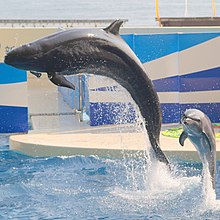The false killer whale has not been extensively studied in the wild; much of the data about it has been derived by examining stranded animals.

Discovery
The false killer whale was first described by the British paleontologist and biologist Richard Owen in his 1846 book A history of British fossil mammals and birds.[3] He based this work on a fossil discovered in 1843 in the great fen at the neighourhood of Stamford, Lincolnshire. Owen proposed to name the cetacean Phocaena crassidens and, by comparing its characteristics and dimensions, noted a general resemblance to those of the grampus (Phocaena orca) and the round-headed porpoise (Phocaena melas).[3]The species was thought extinct until Johannes Reinhardt confirmed it was alive when he described a large pod at the Kiel Bay in 1861. One of these was captured, and others were found the following year, beached on the coast of Denmark.[4]
Population and distribution
The false killer whale appears to have a widespread, if small, presence in tropical and semitropical oceanic waters. A few of these whales have been found in temperate water, but these are probably stray individuals. Their most common habitat is the open ocean, though they also frequent other areas.[5] They have been sighted in fairly shallow waters such as the Mediterranean Sea and Red Sea, as well as the Atlantic Ocean (from Scotland to Argentina), the Indian Ocean (in coastal regions and around the Lakshadweep Islands), the Pacific Ocean (from the Sea of Japan to New Zealand and the tropical area of the eastern side), and in Hawaii.The Hawaii populations are the most studied groups of false killer whales. The three distinct groups in the islands are an offshore population, a northwestern Hawaiian Island group, and a small group around the main Hawaiian Islands. This last group, a unique, small, insular population, is genetically distinct from the other populations.[6]
A false killer whale and a bottlenose dolphin mated in captivity and produced a fertile calf.[7] The hybrid offspring has been called a “wholphin”.
Description

Human interaction
False killer whales are kept in captivity and studied in the wild by scientists. Several public aquaria display false killer whales. For example, Okinawa Churaumi Aquarium in Japan displays false killer whales in the Okichan Theater.[10] A false killer whale and a bottlenose dolphin mated in captivity and produced a fertile calf.[7]These whales have been known to approach and offer fish they have caught to humans diving or boating.[5][6]
Scientist have undertaken research to understand more about the species—including population surveys, satellite tagged individual whales, and carcasses studies. From these studies, they determined information about habitat, range, and distinct populations. Recent study of the local population of false killer whales in Hawaii shows evidence of a dramatic decline over the last 20 years. Five years of aerial surveys from 1993 through 2003 show a steep decline in sighting rates. Group sizes of the largest groups documented prior to 1989 surveys were almost four times larger than the entire 2009 population estimate.[6]
Beachings
On 2 June 2005, up to 140 (estimates vary) false killer whales were beached at Geographe Bay, Western Australia.[13] The main pod, which had split into four separate strandings along the length of the coast, was successfully moved back to sea, with only one death after the intervention of 1,500 volunteers, coordinated once again by the Department of Conservation and Land Management.
Just prior to sunrise on 30 May 2009, a pod of 55 false killer whales was discovered stranded on a sandy beach at Kommetjie in South Africa (latitude 34° 8′ 3.98″ S, longitude 18° 19′ 58.22″ E).[14] Despite the efforts of over 50 volunteers, most animals re-beached themselves and the weather complicated further attempts.[15] Authorities euthanized 44 whales.
As of July 2014, there is no record of an orphaned infant of the species surviving to adulthood after stranding, however, veterinarians expressed hope about the prospects of a six-week-old male calf found on the shores of North Chesterman beach, near Tofino, British Columbia.[16] He was found in critical condition on July 11, 2014 and received care at the Vancouver Aquarium.[16][17]
Conservation

The false killer whale is covered by the Agreement on the Conservation of Small Cetaceans of the Baltic, North East Atlantic, Irish and North Seas (ASCOBANS), and the Agreement on the Conservation of Cetaceans in the Black Sea, Mediterranean Sea and Contiguous Atlantic Area (ACCOBAMS). The species is further included in the Memorandum of Understanding Concerning the Conservation of the Manatee and Small Cetaceans of Western Africa and Macaronesia (Western African Aquatic Mammals MoU) and the Memorandum of Understanding for the Conservation of Cetaceans and Their Habitats in the Pacific Islands Region (Pacific Cetaceans MoU)
In November 2012, the United States' National Oceanic and Atmospheric Administration recognized the Hawaiian population of false killer whales, which numbers around 150 individuals, as endangered.[18]




No comments:
Post a Comment
Note: Only a member of this blog may post a comment.